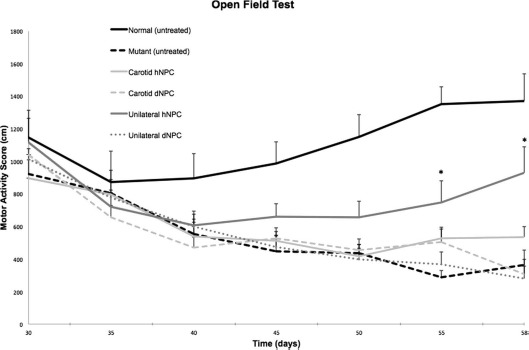Figure 2.

Open-field test was used to assess the effect of NPCs on motor activity in five groups of sHW rats: hNPCs (n = 12) or dNPCs (n = 12) injected into the common carotid artery, hNPCs (n = 12) or dNPCs (n = 12) implanted directly into the hippocampus and cerebellum, and untreated mutants (n = 12) and normal Han–Wistar rats (n = 12). All mutant rats exhibited decreased motor activity regardless of treatment. The data show that the carotid injection of hNPCs did not improve motor coordination as the ataxia progressed except at 58 days of age (p < 0.05). After the initial drop in activity (prior to stem cell inoculation), the unilaterally implanted hNPC group showed increased motor activity scores compared to the dNPC group (p < 0.001). As expected, untreated normal rats showed the highest rate of motor activity, while untreated mutants had a slow, steady decrease in activity due to the progression of neurodegenerative disease. All values are means ± SEM; asterisks indicate significant difference in motor activity score between the live hNPC group and other mutants (p < 0.05). NPC, neural progenitor cell; hNPCs, human-derived neural progenitor cells; dNPCs, dead neural progenitor cells; sHW, spastic Han–Wistar rats; SEM, standard error of the mean.
